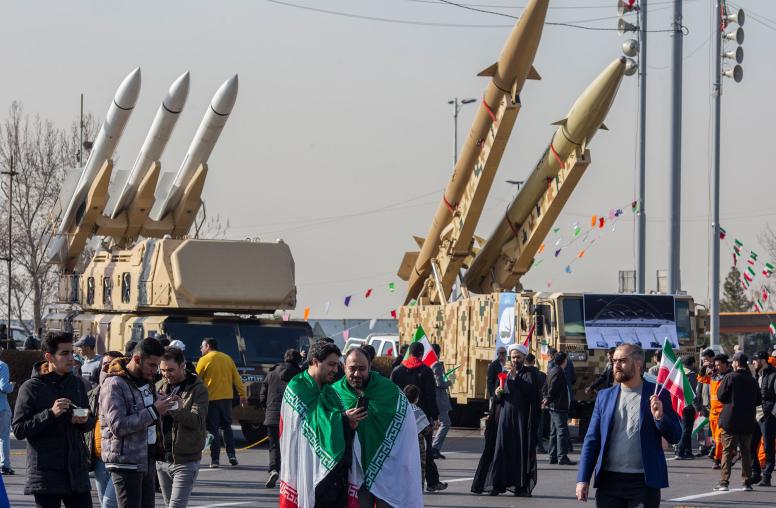How Should the U.S. Respond to China’s Brazen Pursuit of Spratly Islands Claim?
Tensions between China and the Philippines over control of Second Thomas Shoal raise the risk of a U.S.-China confrontation.
In recent weeks, the People’s Republic of China (PRC) has dispatched ships and other maritime forces to the disputed Spratly islands near the Philippines. The goal has been to coerce the Philippines into withdrawing from the contested Second Thomas Shoal, effectively ceding it to the PRC. China’s actions are in defiance of the international Permanent Court of Arbitration’s findings that undermine PRC claims to the Spratlys. They therefore constitute a serious challenge to the international rules governing maritime conduct, as well as to broader peace and stability in the South China Sea, through which enormous amounts of global trade flow.

The Spratlys Situation
The Spratlys are a group of geographic features including reefs, shoals and rocks located near the Philippines, Brunei and Malaysia — and several hundred miles from China’s shores. The area is claimed by the PRC, Taiwan (as the Republic of China), Vietnam, the Philippines, Malaysia and Brunei.
Of these, the PRC’s claims are the most expansive. The PRC has long claimed control (without specifically using the term “sovereignty”) over territory within the so-called “nine-dash line,” a region which encompasses much of the South China Sea, including the Spratlys. However, the PRC hasn’t quite specified whether it claims only the land features, or the waters as well.
Over the years, the PRC has become more assertive in supporting its ambiguous claims. It has extended patrols of the area, often arresting foreign fishing boats for violating the nine-dash line while requiring anyone who wishes to fish there to first register at the prefecture-equivalent capital of Sansha in the Paracels.
China has also undertaken extensive land reclamation at rocks and reefs under its control, totaling over 3,000 acres in artificial island in the Spratlys — dwarfing all other claimants combined. Despite promises not to militarize these new features, the PRC has deployed artillery pieces and rockets and built runways that can support both fighter and cargo aircraft.
China is not the first or only country to militarize in the Spratlys (Vietnam was the first to build an airstrip in the area in 1976). It’s the scale and undeterred expansion of China’s military presence in the region that warrants international attention.
By 2013, Chinese efforts had become so pressing and brazen that the Philippines chose to submit the dispute to the Permanent Court of Arbitration at the Hague (PCA). Beijing not only refused to participate in the hearings, but repeatedly denounced the court and condemned the Philippines for choosing to pursue arbitration (as allowed under the U.N. Convention on the Law of the Sea, or UNCLOS), demanding that the Philippines instead restrict itself to bilateral negotiations with Beijing.
The situation did not improve after the PCA handed down a ruling in 2016. The PCA rejected the Chinese position that they had historical claims to the various features in the Spratlys, effectively nullifying the main PRC basis for claiming features so far from its own shores. In effect, the PCA found the Chinese nine-dash line did not constitute a basis for making claims under UNCLOS.
Moreover, according to the PCA’s findings, none of the contested features in the Spratlys are “islands,” in the legal sense, but rather “rocks” or “low-tide elevations.”
Under UNCLOS, only islands can have an exclusive economic zone — an area that extends 200 nautical miles from the shore that grants its owner first rights to all resources (e.g., fish, petroleum or minerals). Meanwhile, features considered “rocks” are only entitled to a 12-nautical-mile radius of “territorial waters,” while those considered “low-tide elevations” generate no jurisdictional benefit at all.
By deciding the Spratlys only contained rocks or low-tide elevations, the PCA effectively ruled that none of these features generate their own exclusive economic zone in the South China Sea. The PRC rejected the PCA’s findings out of hand and has subsequently continued to militarize the islands under its control, deploying garrisons on many of them.
Second Thomas Shoal
As part of its longer-term effort to dominate the Spratlys, China has repeatedly tried to force the Philippines from its position on Second Thomas Shoal. Since 1999, the Philippine presence is comprised of a beached Philippine Navy ship, the BRP Sierra Madre, and its associated garrison of Philippine marines.
This would seem to be an effort by Manila to exploit the U.S.-Philippines mutual defense treaty. Under Article V of that treaty, the mutual defense provisions could be invoked in the event of an “armed attack on either of the parties,” which is deemed to include “an armed attack on the metropolitan territory of either of the parties, or on the island territories under its jurisdiction in the Pacific or on its armed forces, public vessels or aircraft in the Pacific.”
Deploying a Philippine naval vessel and marines to Second Thomas Shoal would mean any attack on them could bring the United States into the dispute.
The Chinese have, in turn, sought to blockade the Philippine garrison. In 2014, 2021 and again just last week, Chinese Coast Guard (CCG) vessels used water cannons to drive off civilian Philippine vessels contracted to resupply the Philippine forces at Second Thomas Shoal. And earlier this year, China dispatched an array of fishing boats (almost certainly part of the expansive Chinese maritime militia), CCG vessels and even People’s Liberation Army (PLA) naval forces to the Spratlys.
Risks of U.S.-China Confrontation
China is clearly intent upon coercing the Philippines out of its position in the Spratlys, regardless of the Philippines’ formal legal rights and claims. Indeed, it is quite likely that the PCA findings have only strengthened the PRC’s resolve to secure the Spratlys (as well as the separate Scarborough Shoal and Macclesfield Bank territories). At the same time, the PRC is likely trying to signal to the region that American support is both escalatory and counterproductive.
Chinese employment of CCG vessels is part of the broader PRC effort in both legal warfare and gray zone warfare. Chinese definitions of legal warfare, as described in the newspaper of the PLA’s National Defense University, note that it involves not only legislation, judicial law and legal pronouncements, but also policy consultations, legal education and other associated elements of the legal enterprise.
For the Chinese, the use of law enforcement vessels such as CCG cutters is a political signal that the territories in question are, in fact, Chinese. The PRC wants to appear as though it is enforcing its laws on its territories through its own law enforcement agencies — in this case, the CCG. If there were a real dispute, the Chinese would deploy external security forces, such as the Chinese Navy.
Moreover, for the broader, global audience, China is trying to shape public opinion by dispatching white-hulled coast guard cutters, not combatants, to support its claims. One can be sure that Chinese news agencies will neither discuss the size and armament of CCG vessels (some of which displace as much as World War II heavy cruisers), nor the presence of Chinese Navy vessels just over the horizon.
However, should the United States intervene — especially with U.S. Navy warships — the comparison of “white hull” law enforcement cutters versus “grey hull” warships will be emphasized globally. That the Chinese actions are in violation of the PCA’s findings, of course, will be ignored in the PRC’s narrative.
But if the United States were to not respond, its credibility as an ally will be called into question, certainly by Manila. The various efforts to renew U.S. access to Philippine facilities under the Enhanced Defense Cooperation Agreement, especially in the event of a Taiwan contingency, will certainly falter. Why should the Philippines support American efforts to support Taiwan if the United States won’t support the Philippines?
As important, it will signal to Beijing that American willingness to confront Chinese salami-slicing tactics against its neighbors remains hollow. It is worth recalling that in 2012, the United States chose to persuade the Philippines to withdraw from Scarborough Shoal (a separate set of features north of the Spratlys) while making no effort to compel the PRC to do the same. In effect, Washington forced Manila to cede that set of features to the PRC.
This was followed by a three-year hiatus in U.S. freedom of navigation operations in the South China Sea, an absence that coincided with massive Chinese construction efforts on features it controlled. For the United States to once again fail to counter Chinese efforts to dominate a region that sees some $3.37 trillion in trade would reinforce a perception of American withdrawal.
There are substantial risks, however. While the Spratlys are farther from China than Taiwan (some 730 miles from Hainan, rather than 150 miles in the case of Taiwan), they are nonetheless in China’s front yard. Chinese military forces would therefore bring far more air, sea and missile forces to bear on short notice. As important, Chinese forces would be operating at the end of a much shorter logistical chain, and the ongoing conflict in Ukraine has once again demonstrated that modern warfare consumes munitions, spare parts and other supplies at prodigious rates.



